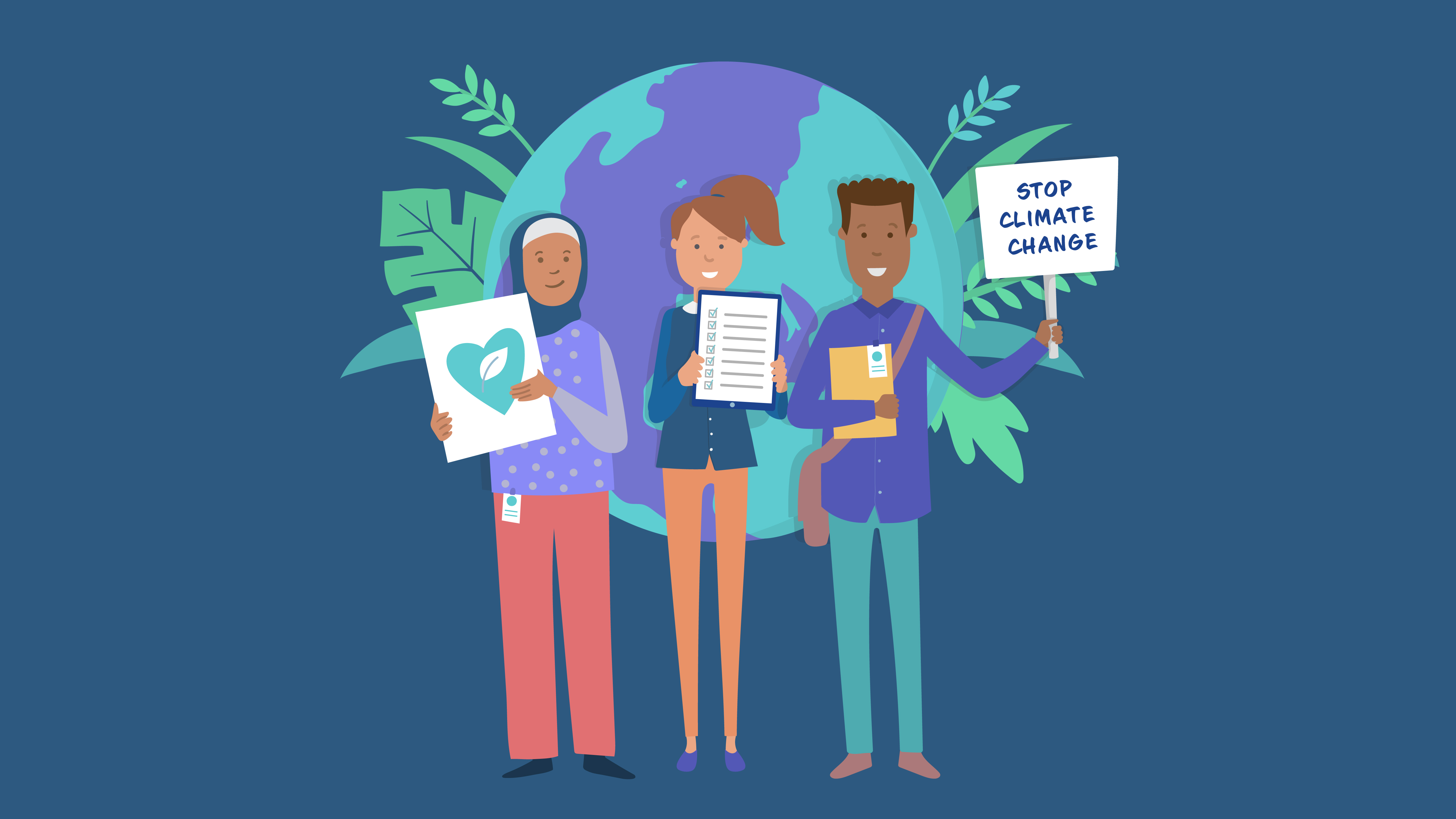
Illustration by Madalina Pavel (Picturise)
Youth eco-activism in Europe: participating in creating another world
by Jamie Gorman
Young people are stepping up to lead the way for action on climate justice across Europe. The school strikes for climate of 2018-2019 were the largest ever global climate mobilisations. Co-ordinated by young people, the strikes captured global attention and demanded action for climate justice in line with equity and science.
These mobilisations led the way in calling for more ambitious and equitable climate action, raising the issue in the public discourse and contributing momentum towards new climate policy. Yet while governments have responded with policies such as the European Green Deal, young people such as indigenous Sámi youth in Norway have continued to call for systemic change as well as create alternative spaces of radical care, community, solidarity and hope.
In this way, as we’ll explore in this article, young people’s environmental activism can be seen as participation in creating another world. Below, we’ll look at the impact of the climate crisis on young Europeans, explore where and how they are participating in environmental action and consider the response of the youth sector to young people’s climate activism.
 Climate justice and young people
Climate justice and young people
While young people’s increasing participation in climate politics is inspiring and hopeful, the context for their stepping up is stark. According to the Intergovernmental Panel on Climate Change (IPCC), there is “a rapidly closing window of opportunity to secure a liveable and sustainable future for all” (IPCC 2023). This closing window poses particular risk to young people’s enjoyment of their human rights now and into the future. After decades of global inaction on emissions, the task of responding to the climate crisis falls most heavily on young people and future generations. They face an intergenerational injustice by being forced to bear the burdens of past generations’ actions. For example, a 2021 study estimated that children born in 2020 will experience a two- to seven-fold increase in extreme climate events, particularly heatwaves, compared to those born in 1960. This injustice is addressed with the legal principle of intergenerational equity in environmental governance, “a concept of fairness among generations in the use and conservation of the environment and its natural resources” (Wiess 2013). It is a foundational concept for sustainable development (found in the 1972 Stockholm Declaration) and of climate justice (articulated in the preamble of the 2015 Paris Agreement).
Of course, the burdens of climate change do not fall on all young people equally. Young people will experience risks disproportionately due to other intersecting identities, with class, ethnicity, geography, gender and sexual identity playing a role in shaping young people’s varied exposure to environmental risks and protection factors. Young people in the global south and those experiencing inequality and discrimination in Europe, are particularly at risk, with the IPCC (2021) reporting that:
Vulnerability of ecosystems and people to climate change differs substantially among and within regions …, driven by patterns of intersecting socio-economic development, unsustainable ocean and land use, inequity, marginalization, historical and ongoing patterns of inequity such as colonialism, and governance.
Recognising these drivers of climate vulnerability, many young activists have adopted an intersectional analysis of the climate crisis and engage in solidarity work with other movements. Intersectionality is a concept which highlights how different categories of identity (e.g. gender and ethnicity) interact to shape a person’s experience. An intersectional approach to climate justice seeks to address the differentiated impacts and experiences of the climate crisis for people of different identities and locations. Young climate activists in Europe are increasingly aware of and working to educate themselves around intersectionality.
 A long history of environmental participation
A long history of environmental participation
While young people have made headlines in the last number of years, young people have a long history of environmental participation in Europe. International Young Naturefriends was founded in 1895 with an emancipatory approach that sought to “analyse and explain the everyday environment to young people so that relationships and the backgrounds of industrial society become more visible” (Mrkev 2019: 102). This led the organisation to be active in the anti-nuclear energy and disarmament movements. Similarly, Scouting and Guiding have long been a vehicle for young people’s environmental action. Young people and students were pivotal to social activism of the 1960s across Europe (Bessant 2021) and the emergence of the modern environmental movement in the 1970s (Järvikoski 1995). Since the 1990s, young people have been involved in environmental activism in many ways, from the mass mobilisations of the alter-globalisation movement, to the civil disobedience of the climate justice movement and the youth sections of the major environmental movement organisations, like Young Friends of the Earth Europe. The current wave of youth environmental action is a continuation of these trends rather than something entirely new.
 Demographics and concerns of young climate activists
Demographics and concerns of young climate activists
Young Europeans are not monolithic in their experiences or uniform in their perspectives on environmental issues. Several major studies seek to capture a snapshot of participation in the major school strikes of 2019 and 2020 (de Moor et al. 2020; Wahlström et al. 2019). These studies suggest that mobilisations in major cities were predominantly made up of young women and largely from middle class families. More research is needed to understand the perspectives of other young people, and particularly rural and working class youth whose environmental participation is less understood. It may be that such young people are “less likely to see themselves as orchestrators of their own existence and ultimately as lacking environmental-political agency”, as Arya and Henn (2021) found in a UK study with young working class Londoners. Outside of the European context, in Australia, researchers found that rural youth face structural barriers to their participation in the climate movement (Arnot et al. 2022). Youth work and youth policy have a role to play in supporting marginalised young people to act on climate in ways that connect with their lives and interests.
Research suggests that young people generally adopt a more radical and justice-orientated understanding of climate change.
While taking into account young people’s diversity, research suggests that they generally adopt a more radical and justice-orientated understanding of climate change (Neas et al. 2022: 6). The school strikers of Fridays for Future articulated three core demands in their 2019 Lausanne Climate Declaration:
- Keep the global temperature rise below 1.5°C compared to pre-industrial levels.
- Ensure climate justice and equity.
- Listen to the best united science currently available.
These demands suggest that young people want to see structural change rather than reform.
 What does youth environmental participation look like?
What does youth environmental participation look like?
For those of us who are adults in the youth sector, it is important to reflect on our assumptions when we’re thinking about young people’s environmental participation.
Beyond the major mobilisations of recent years, young people today are participating in environmental and climate activism in a great diversity of ways. For those of us who are adults in the youth sector, it is important to reflect on our assumptions when we’re thinking about young people’s environmental participation. Buckley and Bowman (2021) suggest that a typical approach by which adults have understood youth climate activism is to measure it in terms of civil engagement with adult-centred institutional politics. For example, young people from Portugal are taking legal action at the European Court of Human Rights, or through the EU Youth Dialogue. Similarly, young people who are engaging in political consumerism such as boycotting and “buycotting” may be seen as doing “legitimate” activism.
However, Buckley and Bowman (2021) argue that this civic engagement lens on youth participation has the effect of judging young people’s participation on adults’ terms, often leading to a narrow definition of what is “real”, meaningful and effective participation and what is not. Researchers from the Partispace project, which explored young people’s participation across Europe, also found that adults can limit their understanding of participation to activities which comply with the established societal rules and norms (Batsleer et al. 2020: 202). Young people who are engaged in civil disobedience or experimenting with social alternatives may be labelled as deviant and experience repression. For example, the students across Europe who are occupying their schools and organising teach-ins for climate action and the activists who blockade fossil fuel infrastructure.
Batsleer and colleagues (2020: 199) define participation as “biographical self-determination” that takes place “in the public and/or through the use of public institutions”. In this definition, whenever young people are acting to express their identity in a public space then it can be considered participation. This definition aligns with Buckley and Bowman’s (2021: 13) suggestion that the climate strikes are a form of “transnational cultural exchange” between young people, where their “politics are related to their self-expression” as they engage in sharing, mutual-aid and “negotiating solidarity based on positionalities”.
This points us beyond participation in formal decision-making spaces and adult-created governance structures to the radical democratic experimentation of young people who are seeking to shift social norms and cultural practices. This political strategy is known as prefiguration, or what Pickard (2022) calls young people’s ‘Do-It-Ourselves’ (DIO) politics:
a form of participatory politics, whereby citizens do personal everyday acts and/or collective actions outside elections and traditional institutional politics to bring about change. Both personal and collective DIO politics fundamentally involve doing something beyond electoral channels about a grievance or a hope. (Pickard 2022: 732)
There are an enormous range of activities in this category of youth environmental participation. Young activists are building sustainable alternatives to the status quo in many ways, such as community bicycle projects, permaculture farming and repair cafes. Youth are creating and contributing to spaces for networking, alliance building and non-formal and informal learning (e.g. summer schools and Erasmus+ projects). What is common to all these forms of participation is that they are enacting alternative visions for the world in the here and now, and not necessarily measuring success in terms of engagement with or responses from adult institutions.
 How the European youth sector is responding to young people’s climate activism
How the European youth sector is responding to young people’s climate activism
European youth policy has tended to keep climate change “at arm’s length”, according to Siurala (2022: 36). And while the climate crisis is now emerging on the youth policy agenda, its adoption at a national level across Europe is “accompanied with hesitancy, ambivalence and differences of opinion” (Siurala 2022: 31). This prompted the topic of the 2021 Offenburg Talks: “How green is youth work?”
At a European level, there have been several significant developments in recent years which may support and catalyse further action at national level. The European Union (EU) has adopted the European Green Deal and European Climate Pact, as well as taking action to establish a Just Transition Fund. The EU’s priorities for the Erasmus+ programme now include environment and sustainability and there is a focus on activities in these areas as part of the European Solidarity Corps programme. In the Council of Europe, the Parliamentary Assembly of the Council of Europe (PACE) has adopted several texts that call for the right to a healthy environment to be recognised as a basic human right. The Joint Council on Youth (CMJ) has held two consultative meetings on young people and the climate crisis (in February 2021 and February 2023) which have contributed to ongoing (at the time of writing) deliberations on a Committee of Ministers recommendation on the climate crisis and young people.
The Youth Partnership has taken the lead on resourcing the youth sector with research and practical tools to support youth work. The training kit (T-Kit) on sustainability and youth work (2018) provides youth workers with a range of resources to explore green issues. In October 2021, the Sustainability checklist was published, with versions available in Spanish and French. An animated video from the checklist and a podcast Greening the youth sector are also available. In terms of research, the Youth Partnership has produced an analytical paper Disobedient youth: lessons from the youth climate strike movement, and an accompanying animated video: What’s up with the youth climate strike movement? Most recently, the Youth Partnership is preparing a Youth Knowledge Book on youth, democracy and the climate crisis to be published in 2024. It will showcase a range of research from across Europe and explore diverse topics from the experiences of rural youth activists to the role of youth work in supporting young people’s climate activism.
 Conclusion
Conclusion
Climate justice draws our attention to the fact that those who have done least to cause the climate crisis will bear the brunt of its impact as it exacerbates existing inequalities. Young people today and future generations are born into a crisis not of their making. Despite this, they are standing up to make and remake their worlds, shaped by visions of justice, care, community and sustainability. They are participating in creating another world in many different ways. Adults in the youth sector can learn much from them.
 References
References
Arnot G. et al. (2022), “‘It shows we are serious’: Young people in Australia discuss climate justice protests as a mechanism for climate change advocacy and action”, Australian and New Zealand Journal of Public Health Vol. 47, No. 3, pp. 1-7.
Arya D. and Henn M. (2021), “The impact of economic inequality and educational background in shaping how non-activist ‘Standby’ youth in London experience environmental politics”, Educational Review Vol. 75, No. 1, pp. 93-114, DOI: 10.1080/00131911.2021.2007051.
Batsleer J., Lüküslü D. and Rowley H. (2021), Young people, radical democracy and community development, Policy Press, Bristol.
Batsleer J., Walther A. and Lüküslü D. (2020), “Struggle over participation: towards a grounded theory of youth participation”, in Walther A. et al. (2020), Young people and the struggle for participation: contested practices, power and pedagogies in public spaces, Routledge, London.
Bessant J. (2021), Making people up: youth, truth and politics, Routledge, London.
Buckley C. G. and Bowman B. (2021), Not (just) a protest: the Youth Strike for Climate as cultural exchange and collaborative text, Research report, British Council.
De Moor J. et al. (eds) (2020), Protest for a future II: Composition, mobilization and motives of the participants in Fridays For Future climate protests on 20-27 September, 2019, in 19 cities around the world, DOI: 10.17605/OSF.IO/ASRUW.
Intergovernmental Panel on Climate Change (2023), “Summary for Policymakers”, in Climate Change 2022: Impacts, Adaptation and Vulnerability, Contribution of Working Group II to the Sixth Assessment Report of the Intergovernmental Panel, Cambridge University Press, Cambridge.
Järvikoski T. (1995), Young people as actors in the environmental movement, YOUNG Vol. 3, No. 3, pp. 80-93, DOI: 10.1177/110330889500300306.
Mrkev P. (2019), “International Young Naturefriends”, in Williamson H. and Basarab T. (eds), The history of youth work in Europe (vol. 7), Council of Europe Publishing, Strasbourg.
Neas S., Ward A. and Bowman B. (2022), “Young people’s climate activism: a review of the literature”, Frontiers in Political Science Vol. 4 (940876), pp. 1-13.
Pickard S. (2022), “Young environmental activists and Do-It-Ourselves (DIO) politics: collective engagement, generational agency, efficacy, belonging and hope”, Journal of Youth Studies Vol. 25, No. 6, pp. 730-50, DOI: 10.1080/13676261.2022.2046258.
Siurala L. (2022), Youth work and climate change: a follow up on the 2019 Finland’s Presidency EU Council debate and questions about the future, Ministry of Education and Culture, Helsinki, Finland.
Wahlström M. et al. (eds) (2019), Protest for a future: composition, mobilization and motives of the participants in Fridays For Future climate protests on 15 March, 2019 in 13 European cities: https://protestinstitut.eu/wp-content/uploads/2019/07/20190709_Protest-for-a-future_GCS-Descriptive-Report.pdf.
Weiss E. B. (2013), “Intergenerational equity’, Oxford Public International Law: https://opil.ouplaw.com/view/10.1093/law:epil/9780199231690/law-9780199231690-e1421.

Jamie is a community and youth worker, researcher and educator who is passionate about social pedagogy, young people's activism and climate justice.


